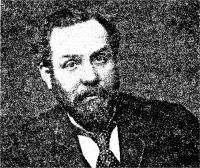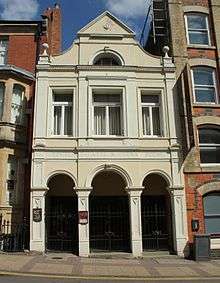Charles J. Phipps
| Charles J. Phipps | |
|---|---|
 Phipps in 1890 | |
| Born |
1835 Bath |
| Died | 25 May 1897 |
| Occupation | Architect |
| Known for | Savoy Theatre |
Charles John Phipps FSA, known as C.J. Phipps (1835 – 25 May 1897) was an English architect best known for his theatres.
Biography
Born in Bath, his first major work was the rebuilding of Theatre Royal, Bath in 1862/3, after the old theatre had been destroyed by fire. Moving to London, he quickly established himself as the leading theatrical architect, building, in rapid succession, the Queen's Theatre (1867), the Gaiety Theatre (1868), the Olympic Theatre (1870) and the Vaudeville Theatre (1871). His Savoy Theatre (1881), a state-of-the-art facility, was the first public building in the world lit entirely by electric light.[1] Other major London theatres included the Strand (1882), the Prince's (1884), the Lyric (1888), the original Shaftesbury Theatre (1888), the Garrick (1889), the Tivoli (1890) and Daly's (1893). In addition the Phipps's London theatres, he was responsible for over forty theatres in the provinces. He also designed Leinster Hall in Dublin (opened in 1886 and closed in 1895), the Star and Garter Hotel at Richmond (demolished in 1919) and the Savoy Turkish Bath.
Phipps was chosen to design the Royal Institute of British Architects’ own premises at 9 Conduit Street. The building is still there, though no longer occupied by the RIBA (now in Portland Place) and is considered by some to reflect the influence of the architect’s native town. He was a fellow (1866) of the Royal Institute of British Architects, serving on its council in 1875-6, and also of the Society of Antiquaries.[2]
Phipps died on 25 May 1897, aged 62.
Family
On 10 April 1860, he married Miss Honnor Hicks, by whom he had issue two sons and three daughters. For some time previous to his death he had been associated in partnership with his son-in-law, Mr. Arthur Blomfield Jackson.[2]
Theatres
Among the theatres Phipps designed, or co-designed, are:
- Theatre Royal, Bath (1862/3)
- Theatre Royal, Nottingham (1865)
- Theatre Royal, Brighton (1866)
- Queen's Theatre, Long Acre (1867)
- Gaiety Theatre, London (1868)
- Olympic Theatre (1870)
- Varieties Music Hall, Hoxton (1870), demolished c. 1980
- Vaudeville Theatre, London (1871)
- Gaiety Theatre, Dublin (1871)
- Theatre Royal, Glasgow (1880) and (1895) the largest surviving example of his work.
- Theatre Royal, Belfast (1881), demolished 1961
- Savoy Theatre, London (1881)[3] (rebuilt 1929)
- Royal Strand Theatre (1882, demolished 1905)[4]
- Royal Lyceum Theatre, Edinburgh (1883)
- Royal Hippodrome Theatre (originally Theatre Royal and Opera House), Eastbourne (1883)
- Prince's Theatre, London (1884) also known as the Prince of Wales Theatre; demolished 1934[5]
- Royal Theatre, Northampton (1884)
- Theatre Royal, Portsmouth (1884)
- Theatre Royal, Exeter (1886), destroyed by fire 1887
- Lyric Theatre, London (1888)
- Original Shaftesbury Theatre (1888)
- Garrick Theatre, London, with Walter Emden (1889)
- Tivoli Theatre, London (1890), demolished 1957
- Queen's Hall (1893), (preliminary designs only) bombed in 1941
- Daly's Theatre (1893), demolished
- Grand Theatre, Wolverhampton (1894)
- Folly Theatre (1895), never built
- Her Majesty's Theatre, London (1897)
Gallery of architectural work
-

Her Majesty's Theatre, London (1897)
-

Royal Theatre, Northampton
References
- Attribution
![]() This article incorporates text from a publication now in the public domain: Waterhouse, Paul (1901). "Phipps, Charles John". In Sidney Lee. Dictionary of National Biography, 1901 supplement. London: Smith, Elder & Co.
This article incorporates text from a publication now in the public domain: Waterhouse, Paul (1901). "Phipps, Charles John". In Sidney Lee. Dictionary of National Biography, 1901 supplement. London: Smith, Elder & Co.
Sources
- Guide to British Theatres 1750–1950, John Earl and Michael Sell pp. 279–82 (Theatres Trust, 2000) ISBN 0-7136-5688-3